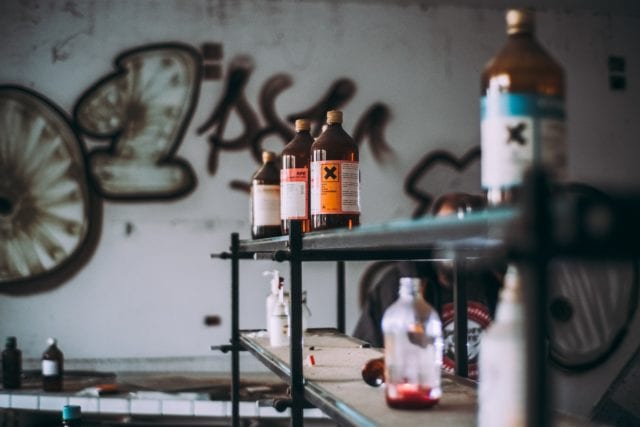Pica: Is it possible to eat anything other than food?
Clay, paint, hair, glue—most would revolt at the thought of consuming these substances. However, someone with pica regularly craves them. Pica is an eating disorder in which non-food items with no nutritional value are eaten. Compulsively eating unedible substances can be detrimental to both physical and mental health. Continue reading for more about this rare, yet intriguing disorder.

What is Pica?
It is a psychological eating disorder characterized by consuming non-food substances that have little to no nutritional value. These substances can be biological and naturally occurring or man-made chemical items like hair, ice, or feces, but man-made chemicals such as paint, glue, paper, and chalk are also eaten.
Eating non-food items is not classified as pica unless the individual is over two years of age, as many children put objects in their mouths while learning. The behavior must be ongoing for at least a month and considered both developmentally and culturally inappropriate.
Causes of Pica
The primary causes of it are malnutrition, pregnancy, and intellectual disabilities.
Multiple studies found that a variety of vitamin and mineral deficiencies are linked to it. Patients had deficiencies in iron, zinc, and calcium. Correcting the deficiency through supplementation improved pica cravings. Iron deficiency anemia is common in pregnancy, which is why pregnant women are at a higher risk for developing the disorder. Aligning with malnutrition, hunger is a motivator for it. Eating non-food items creates a feeling of fullness to curb hunger.
Pica Risk Factors
There are risk factors that correlate with the underlying causes of pica. Children and women are more prone to pica; however, those over the age of two of either gender can still develop the disorder. Researchers have concluded that stress, childhood neglect, low socioeconomic status, nutritional deficiency, pregnancy, epilepsy, malnutrition or hunger, and mental health disorders increase the risk of pica.
Signs and Symptoms of Pica
Signs and symptoms consist of regularly consuming non-food items with no nutritional value. In all cases of pica, the behavior is contrary to developmental and cultural norms. For example, a child-eating paper while exploring various behaviors is more appropriate than an adult performing the same act. In some cultures, eating clay (or other non-food items) for medicinal or spiritual beliefs is normal.
Pica is categorized by the non-food items eaten:
- Geophagia—Soil, dirt, sand, clay, or chalk
- Pagophagia—Ice
- Xylophagia—Paper
- Amylophagia—Starch (i.e. cornstarch, laundry starch, etc.)
- Trichophagia—Fibers such as hair, fur, or wool
- Coprophagia—Feces
- Lithophagia—Stones, rocks, or pebbles
- Metallophagia—Metal
- Hyalophagia—Glass
- Tobaccophagia—Cigarette butts or ashes
- Cautopyreiophagia—Burnt matches
- Foliophagia—Leaves or grass
- Plumbophagia—Lead containing substances (i.e. paint)
Health Consequences of Pica
The signs and symptoms of pica begin with consuming non-food items, but as the behavior continues, the disorder has negative repercussions on health and wellbeing. Health complications range from nutritional deficiencies to life threatening medical emergencies like intestinal obstructions, infection, and choking.
Nutritional Deficiencies
It is associated with iron and zinc deficiency. Many assume that the disorder is caused by nutritional deficiencies, but the opposite has also been noted. The hypothesis is that the non-nutritive substances consumed alter the mucosal layers of the gastrointestinal tract. As the mucosal layers are compromised, it impedes nutrition absorption. This mechanism may actually worsen the disorder, as nutrient deficiencies result in the individual experiencing increased non-food cravings to correct what the body is lacking. Consuming non-nutritive substances poses a threat to nutrition when it interferes with consuming a well-balanced diet.
Gastrointestinal Obstructions
The human gastrointestinal tract is not intended to digest the substances those with pica tend to eat. Hair and harder substances (i.e. pebbles, clay, etc.) obstruct the intestines, which prevents food and natural stomach secretions from moving along the tract. As gastrointestinal contents back up, the bowel is at risk for perforation. Experts published in the Annals of General Psychiatry report that intestinal obstruction is the most common complication of pica (2015). Evidence of a bowel obstruction begins with nausea, vomiting, constipation or diarrhea, and severe abdominal pain. The blockage is confirmed via x-ray imaging.
Oral Injuries
Pebbles, stones, ice, and plastic substances are hard and increase the risk of injury. When certain substances remain in the mouth, oral infection, and foul breath are likely. Hard objects are difficult to swallow, easily instigating a choking episode if it becomes stuck in the esophagus. The process of consuming these items is known to damage enamel on teeth, break teeth, and erode the gums. Upon swallowing, tissues of the esophagus are susceptible to tears.
Infection
The main infections related to pica are intestinal infections. When soil or dirt is consumed in excess, worms and parasites enter the body. There is a chance infection stems from consuming feces or substances contaminated by feces. Infection can also result from bacteria invading mouth wounds or ulcers in the gastrointestinal tract. The severity of infection depends on the amount consumed, as well as the type of organism causing the infection.
Poisoning
Lead poisoning is prevalent amongst the pica population, as soil, paint, and other substances contain high levels of lead and other poisons. As the chemicals buildup in the body, the individual may begin to suffer toxic side effects.

Possible symptoms of lead poisoning are a loss of appetite, nausea and vomiting, constipation, headaches, behavioral changes, muscle weakness, fatigue, and a metallic taste in the mouth. Severe lead poisoning, especially in children, lead to brain damage and developmental delays.
How To Diagnose Pica
For a physician to diagnose pica, there is no single test. The diagnosis relies on ruling out other physical or mental causes for the consummation of non-food substances based on a thorough history of the patient. Along with an evaluation based on DSM-5 criteria, the patient should be monitored for intestinal blockages, iron deficiency, and toxic levels of poisons from items ingested.
The Diagnostic and Statistical Manual of Mental Disorders, 5th Edition (DSM-5) outlines the criteria for a pica diagnosis:
- The person must have been eating non-nutritive nonfoods for at least one month.
- This eating must be considered abnormal for the person’s stage of development.
- Eating these substances cannot be associated with a cultural practice that is considered normal in the social context of the individual.
- For people who currently have a medical condition or a mental disorder, the action of eating non-nutritive nonfoods should only be considered pica if it is dangerous and requires extra medical investigation or treatment on top of what they are already receiving for their pre-existing condition.
Mental Disorders Related To Pica
Impaired mental functioning is related to pica. According to the National Eating Disorders Association, approximately 26% of people institutionalized for mental disorders exemplify pica-like behaviors. Additionally, one in every five children in mental health clinics have a diagnosis of pica. Many times,
Obsessive Compulsive Disorder (OCD)
Obsessive compulsive disorder, also referred to as OCD, is a mental condition characterized by intrusive, obsessive thoughts and behaviors. The compulsive behaviors relieve the obsessive thoughts. For example, a fear of germs which causes excessive hand washing. Pica is thought to be in the same realm of OCD, as eating non-food substances is a compulsive behavior.
Intellectual Disability and Autism Spectrum Disorder
Intellectual disability is a below average intelligence that interferes with daily functioning. Reduced mental abilities impact social, practical, and learning skills. Intellectually disability is accompanied by pica when the individual does not possess the intelligence to distinguish edible from non-edible food items. Although a separate condition, autism spectrum disorder also effects life skills. The CDC states that 28% of children with both intellectual disability and autism have pica.
Schizophrenia
Schizophrenia is a mental illness that effects how someone thinks, feels, and behaves. Schizophreniais marked by episodes of psychosis in which they see and hear things that are not there (hallucinations) and have beliefs that conflict with reality (delusions). During episodes of psychosis, those with schizophrenia can consume non-food items.
Trichotillomania (Hair Pulling Disorder) and Excoriation (Skin Picking Disorder)
Trichotillomania is a disorder in which someone compulsively pulls out their hair. When the condition is severe, hair loss is noticeable. Research published in Comprehensive Psychiatry found that 20% of people with trichotillomania demonstrate pica behaviors by eating their hair after pulling it out. Excoriation is a condition characterized by excessive skin picking. Much like trichotillomania, the skin is sometimes consumed. Both disorders are often a way to relieve stress and cope with anxiety.
Pica Treatment
Treatment for pica is to treat any underlying nutritional deficiencies or medical emergencies as a result of the disorder. It is important to address lead poisoning, bowel obstructions, and infection prior to the patient receiving behavioral interventions.
Cognitive Behavioral Therapy (CBT)
Cognitive behavioral therapy is a form of psychotherapy that focuses on how thoughts influence behavior. A trained therapist works with the patient to identify unproductive or false thoughts, feelings, and cognitive distortions to change an unwanted behavior. Instead of engaging in a compulsive behavior, the patient is taught coping mechanisms.
A similar behavioral approach is essential to managing pica. To prevent the compulsive behavior, the therapist and patient discern food items that are safe to consume from harmful, non-food substances. A study by Emory Health Sciences in 2015 followed 11 children with pica and an intellectual disability. The therapy entailed redirecting the child’s behavior towards another activity, blocking them from consuming non-food items by shadowing and rewarding the child with a non-edible item. After weeks of cognitive behavioral therapy, all but one had a 96% reduction in behavior.
Cheletion Therapy
Cheletion therapy is a therapy for lead poisoning. The patient is prescribed a medication that binds to lead in the body. The lead is then expelled through the urine. The medication can be given by mouth, and in severe cases, through an IV.
Medication
There is evidence that pica is connected to low levels of dopamine, a neurotransmitter that relays messages to the body from the nervous system. Medications that increase levels of dopamine have shown minimal efficacy.
References
Emory Health Sciences. (2015). Behavioral therapy effective against pica in children with autism spectrum disorder. Retrieved from https://www.sciencedaily.com/releases/2015/02/150209143533.htm
Grant, J. E., & Odlaug, B. L. (2008). Clinical characteristics of trichotillomania with trichophagia. Comprehensive psychiatry, 49(6), 579–584. https://doi.org/10.1016/j.comppsych.2008.05.002
Lofts RH, Schroeder SR, Maier RH. Effects of serum zinc supplementation on pica behavior of persons with mental retardation. Am J Ment Retard. 1990 Jul;95(1):103-9. PMID: 2386628.
Tokue, H., Takahashi, Y., Hirasawa, S., Awata, S., Kobayashi, S., Shimada, T., Tokue, A., Sano, R., Kominato, Y., & Tsushima, Y. (2015). Intestinal obstruction in a mentally retarded patient due to pica. Annals of general psychiatry, 14, 22. https://doi.org/10.1186/s12991-015-0060-4
Cheyanne is currently studying psychology at North Greenville University. As an avid patient advocate living with Ehlers Danlos Syndrome, she is interested in the biological processes that connect physical illness and mental health. In her spare time, she enjoys immersing herself in a good book, creating for her Etsy shop, or writing for her own blog.